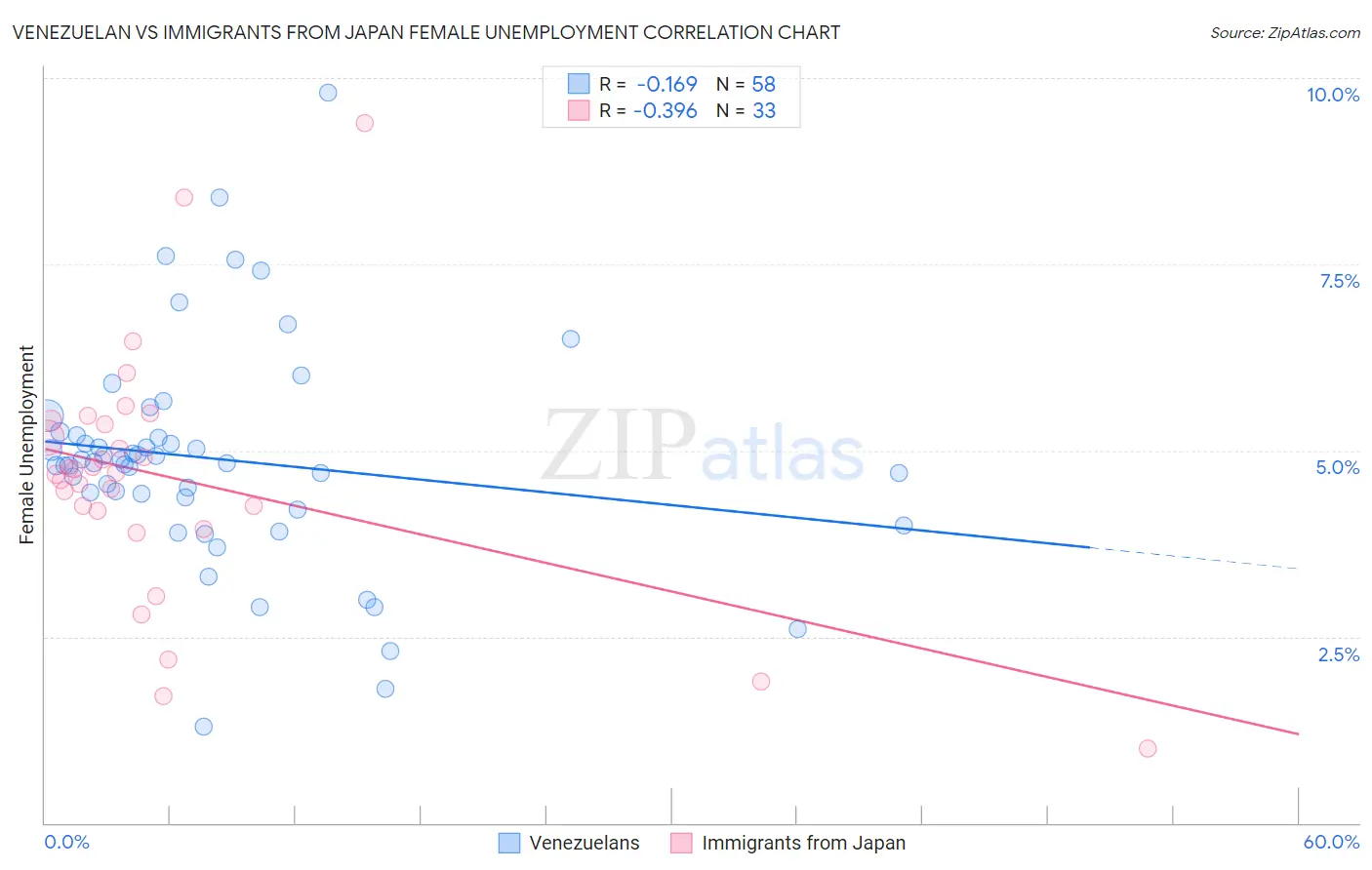Venezuelan vs Immigrants from Japan Female Unemployment
COMPARE
Venezuelan
Immigrants from Japan
Female Unemployment
Female Unemployment Comparison
Venezuelans
Immigrants from Japan
5.0%
FEMALE UNEMPLOYMENT
96.9/ 100
METRIC RATING
87th/ 347
METRIC RANK
5.0%
FEMALE UNEMPLOYMENT
96.0/ 100
METRIC RATING
91st/ 347
METRIC RANK
Venezuelan vs Immigrants from Japan Female Unemployment Correlation Chart
The statistical analysis conducted on geographies consisting of 305,755,404 people shows a poor negative correlation between the proportion of Venezuelans and unemploymnet rate among females in the United States with a correlation coefficient (R) of -0.169 and weighted average of 5.0%. Similarly, the statistical analysis conducted on geographies consisting of 339,198,436 people shows a mild negative correlation between the proportion of Immigrants from Japan and unemploymnet rate among females in the United States with a correlation coefficient (R) of -0.396 and weighted average of 5.0%, a difference of 0.43%.

Female Unemployment Correlation Summary
| Measurement | Venezuelan | Immigrants from Japan |
| Minimum | 1.3% | 1.0% |
| Maximum | 9.8% | 9.4% |
| Range | 8.5% | 8.4% |
| Mean | 4.9% | 4.6% |
| Median | 4.8% | 4.7% |
| Interquartile 25% (IQ1) | 4.4% | 4.1% |
| Interquartile 75% (IQ3) | 5.2% | 5.4% |
| Interquartile Range (IQR) | 0.83% | 1.3% |
| Standard Deviation (Sample) | 1.5% | 1.7% |
| Standard Deviation (Population) | 1.5% | 1.6% |
Demographics Similar to Venezuelans and Immigrants from Japan by Female Unemployment
In terms of female unemployment, the demographic groups most similar to Venezuelans are Bolivian (5.0%, a difference of 0.090%), Immigrants from Sudan (5.0%, a difference of 0.090%), Ukrainian (5.0%, a difference of 0.10%), Canadian (5.0%, a difference of 0.14%), and Immigrants from Taiwan (5.0%, a difference of 0.15%). Similarly, the demographic groups most similar to Immigrants from Japan are Romanian (5.0%, a difference of 0.030%), Immigrants from Austria (5.0%, a difference of 0.10%), Immigrants from Sweden (5.0%, a difference of 0.12%), Immigrants from Malaysia (5.0%, a difference of 0.13%), and Burmese (5.0%, a difference of 0.15%).
| Demographics | Rating | Rank | Female Unemployment |
| Turks | 97.6 /100 | #79 | Exceptional 5.0% |
| New Zealanders | 97.4 /100 | #80 | Exceptional 5.0% |
| Filipinos | 97.3 /100 | #81 | Exceptional 5.0% |
| Immigrants | Australia | 97.3 /100 | #82 | Exceptional 5.0% |
| Immigrants | Serbia | 97.2 /100 | #83 | Exceptional 5.0% |
| Canadians | 97.2 /100 | #84 | Exceptional 5.0% |
| Ukrainians | 97.1 /100 | #85 | Exceptional 5.0% |
| Bolivians | 97.1 /100 | #86 | Exceptional 5.0% |
| Venezuelans | 96.9 /100 | #87 | Exceptional 5.0% |
| Immigrants | Sudan | 96.7 /100 | #88 | Exceptional 5.0% |
| Immigrants | Taiwan | 96.6 /100 | #89 | Exceptional 5.0% |
| Immigrants | Sweden | 96.3 /100 | #90 | Exceptional 5.0% |
| Immigrants | Japan | 96.0 /100 | #91 | Exceptional 5.0% |
| Romanians | 95.9 /100 | #92 | Exceptional 5.0% |
| Immigrants | Austria | 95.7 /100 | #93 | Exceptional 5.0% |
| Immigrants | Malaysia | 95.7 /100 | #94 | Exceptional 5.0% |
| Burmese | 95.6 /100 | #95 | Exceptional 5.0% |
| Immigrants | South Central Asia | 95.5 /100 | #96 | Exceptional 5.0% |
| Immigrants | Somalia | 95.2 /100 | #97 | Exceptional 5.0% |
| Immigrants | Kuwait | 95.2 /100 | #98 | Exceptional 5.0% |
| Immigrants | Zaire | 95.2 /100 | #99 | Exceptional 5.0% |